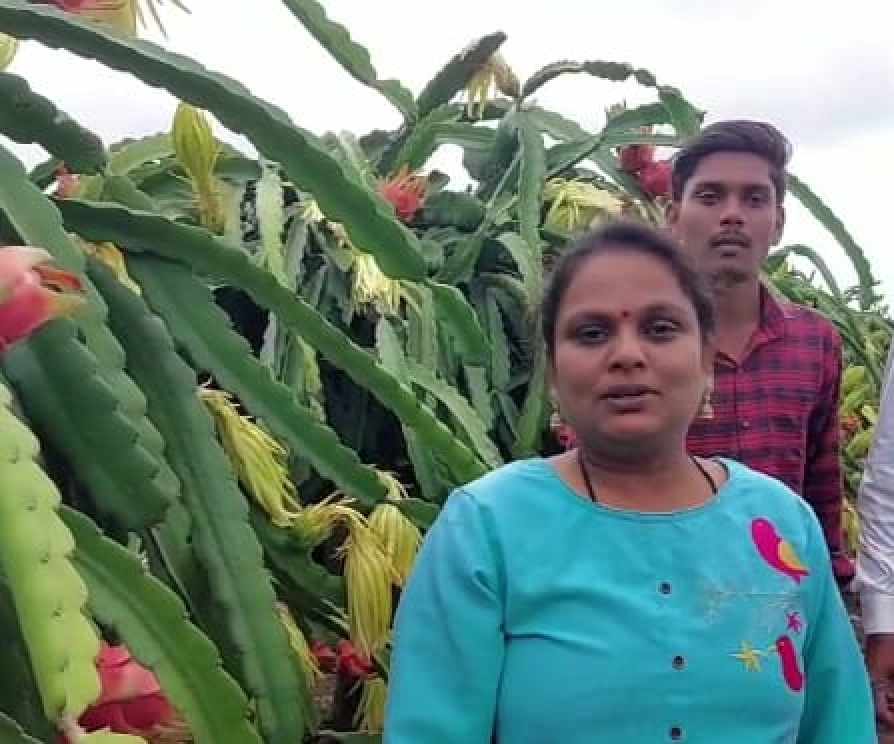
India’s drought-hit farmers make a fruitful pivot to ‘the only crop that can survive’: hardy dragon fruits
- Indian farmers favour dragon fruits for their profitability, resistance to pests, ability to grow in arid conditions and comparatively low water needs
- The high profit margins have even attracted interest from affluent professionals – but not everyone has enjoyed the fruits of their investments
“The annual profit is 50 per cent more as compared to my earnings from grapes and pomegranate that I cultivated before,” she told This Week In Asia. “In drought-affected areas, dragon fruit is the only crop that can survive.”

Several farmers, who previously cultivated traditional crops in the semi-arid and drought-hit regions of Maharashtra, Gujarat, Karnataka and Andhra Pradesh, have over the past six years started to grow dragon fruits instead.
This “exotic” fruit with scaly spikes and high nutrient values was grown only in home gardens thirty years ago, but by 2020, 12,000 tonnes of dragon fruits were being produced annually in India in some 4,000 hectares of land. Cultivation will further expand to 50,000 hectares of land in the next five years, according to the Indian Council of Agricultural Research – National Institute of Abiotic Stress Management
Why did India’s Modi back down on farm laws after prolonged protests?
Dragon fruits, he added, can be cultivated in degraded land and drought-prone areas, across diverse temperature ranges.
They are also resistant to pests and requires less water than other plants such as sugar cane, said 80-year-old Anandrao Baburao Pawar, one of the 700 dragon fruit farmers in Maharashtra’s Sangli district. At summer’s peak, an acre of dragon fruit crop requires about 3,000 (13,600 litres) of water each week. Sugar cane plants, by comparison, need eight times that amount.
NV Deshpande, director of the Yerala Projects Society – a non-profit organisation that helps implement innovative farming techniques in drought-affected areas – said dragon-fruit farmers were able to recoup the initial capital cost for one acre (o. 4 hectares) of cultivation – 350,000 rupees – within three years, while also making 400,000 rupees in cumulative profits. Maintenance costs about 30,000 rupees annually.
This makes dragon fruit cultivation more profitable than growing grapes, for example. Cumulative profits from one acre of grape cultivation barely reach 100,000 rupees over three years, Deshpande said, yet farmers must spend 250,000 rupees on upfront costs and the same amount on yearly maintenance.
Lata Aigale, a farmer in Ajur village of Karnataka’s Belgaum district, said she hoped that the authorities would make it easier for dragon-fruit farmers – who often struggle with start-up costs – to access government subsidies.

Farmer Pawar’s 1,320 dragon fruit plants, which occupy one acre of land, yielded 200kg of fruit in 2017, 1.7 tonnes in 2018, and 6.6 tonnes in 2019.
He then planted 3,280 additional saplings over another acre of land and together those two acres yielded 9.2 tonnes of fruit this year, earning him 820,000 rupees (US$9,900) in profit.
In Madhya Pradesh’s Chiklod village where temperatures can hit 45 degrees Celsius in summer, horticulturist Amitesh Argal, 30, started dragon fruit cultivation last year in rocky, sandy soil that repelled water. Still, he expects to recover his capital investment of 700,000 rupees within the next two years.
Deshpande said dragon-fruit farmers in Maharashtra make profits every year, unlike grape growers, who often owe debts of at least 300,000 rupees at the end of the growing season.
Rice, rice, maybe: could this staple be the latest export to be restricted by India?
The profitability of dragon-fruit cultivation is also attracting investments from affluent professionals.
Investment banker Parth Mirani invested 6 million rupees (US$72,400) in 2018 for nine-acres (3.6 hectares) of dragon fruit cultivation in Central India’s Chhattisgarh state – where the climate is dry throughout the year – which made him an annual profit of 2.5 million rupees from the third year on.
But not all investments have been so successful. Kalpesh Hariya, director of Auroch Agro Products, and his two partners invested some 10 million rupees in six hectares of land in Gujarat’s semi-arid Kutch district in 2014.

The results were poor, at first. Hariya said yields only started to improve in 2016 after they had lowered the soil’s pH level, making it less alkaline, and replanted more than 18,000 saplings. A year and a half later, they harvested some 14 tonnes of fruit.
For Mirani, the investment banker, dragon fruit will soon stop being regarded as “exotic” as large-scale production reduces cost.
Retail prices for dragon fruit have been on the decline in India recently. A year ago, one dragon fruit would set you back almost US$2 in most big Indian cities, whereas now they can be picked up for about 60-80 rupees (72 US cents to 97 US cents) each.

